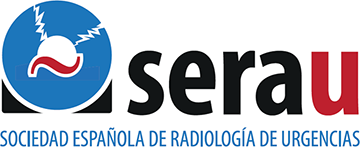Hospital: H G U R S.
Nº: C2019-97
Aut@r o Autores: M. Ojados Hernández, M. Cegarra Navarro, L. Abenza Oliva, L. Sánchez Alonso, J. López Martín, P. Alemán Díaz.
Presentación
A 74-year-old man presents dyspnea few days ago. Chest X-ray shows a left pleural effusion and a large mediastinal mass. In contrast-enhanced chest CT show a well-marginated anterior mediastinal mass with smooth or lobulated contours, heterogenous enhancement due to necrosis or hemorrhage, and linear calcification along the capsule. The mass compresses the left main bronchus producing a lobar atelectasis. An ipsilateral pleural implant and pleural effusion is seen.
Discusión
It´s a thymoma that manifests as dyspnea due to pleural effusion and lobar atelectasis. Thymic neoplasms are rare, less than 1% of all adult malignancies. It´s frequently asymptomatic, 20-30% have symptoms such as cough, chest pain or dyspnea. Thymoma can be detected incidentally on chest radiography. CT is the most commonly used imaging technique to evaluate thymic masses. The size is variable, up to 12 cm. It´s a homogeneous soft tissue mass, with homogenous enhancement although it may have a heterogeneous appearance due to necrosis and hemorrhage. It can have calcifications. Thymoma can metastasize to the pleura (nodules, pleural thickening or pleural effusion) and pericardium (nodules, pericardial thickening or effusion), mediastinum, and lymphadenopathy.
Conclusión
Thymoma is a rare tumor that is usually is asymptomatic mass, however can debut as a infrequent cause of dyspnea due to compression of the bronchus or pleural effusion. The imaging technique of choice is CT.
Bibliografía
- Marcelo FK, Rosado-de-Christenson ML, Sabloff BS, Moran CA, Swisher SG, Marom EM. Role of imaging in the diagnosis, staging, and treatment of thymoma. RadioGraphics 2011, 31:1847–1861. - Nasseri F, Eftekhari F. Clinical and radiologic review of the


